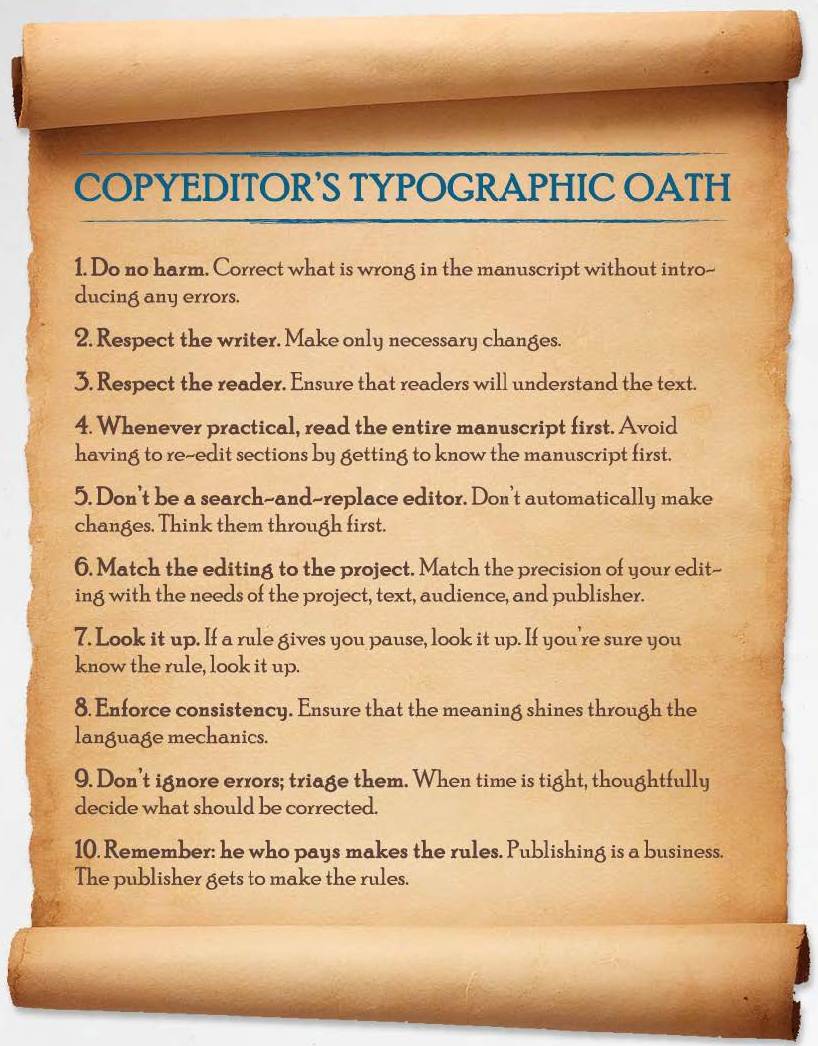Copyediting is a craft that lacks industry standards. Although there are various editing societies and associations, there is no licensing board, no governing organization, and no universal certification. True, you can earn a certificate in copyediting, but the schools and companies offering certification don’t have to offer a standard curriculum. Some publishing and journalism programs teach the entirety of copyediting in one course.
How, then, can we tell a good copyeditor from a poor one? How do we know that what we’ve been taught is adequate? What’s our yardstick?
Let’s start with a set of best practices that all copyeditors can follow, regardless of the type of copyediting they specialize in. These practices should cover the basics. They should be something we can all agree on and something our bosses, our clients, and outsiders can easily understand so that they know when they come across a genuine copyeditor.
It’s time to meet my Copyeditor’s Typographic Oath, a collection of practices that we can all follow to produce the best copy possible. These practices come not just from my experience but also from yours. Many copyeditors have told me what guidelines they thought were important to follow. They are meant to be universal, items every copyeditor can follow for every project, every time.
Here are the 10 best practices—commandments, if you will—that we copyeditors should follow:
1. Do no harm.
Correct what is wrong in the manuscript without introducing any errors.
This first commandment is the most important (and the inspiration for the collection’s name). Our goal is to improve copy, not to make it worse. We need to pay close attention to what the text says and to the changes we make. It’s good practice to read through the manuscript after you’re done editing to ensure that you haven’t introduced any errors. We all make mistakes. Following the rest of these commandments will help reduce errors.
2. Respect the writer.
Make only necessary changes.
Our job as copyeditors isn’t to turn John Smith’s manuscript into John Steinbeck’s. It’s to help Smith’s manuscript be the best it can be while still reading like Smith’s work. We should retain the author’s voice while following the rules of good writing, unless, of course, the publisher says otherwise (see Commandment 10).
Reining in our impulses is one of the hardest lessons for a copyeditor to learn. Be prepared to repeat this popular mantra as often as necessary: “It’s not my book.”
3. Respect the reader.
Ensure that readers will understand the text.
Although we should avoid interfering unnecessarily with the author’s work, changes that will help readers understand the text are critical. In addition to following rules of grammar, usage, spelling, and style, we must strive for clarity throughout the manuscript. When readers can’t understand the text, they stop reading. If an author writes something and no one reads the published work, is the author’s message heard?
4. Whenever practical, read the entire manuscript first.
Avoid having to re-edit sections by getting to know the manuscript first.
Whenever we can, we should read the manuscript before we begin editing. Doing so allows us to identify problem areas, especially those that would require massive rewrites before we can edit. It also allows us to decide the best way to edit the manuscript and to identify any patterns that don’t become clear until later.
When I first introduced this idea, I simply said, “Read the entire manuscript first.” Many readers reminded me that not every copyeditor has such a luxury. When you don’t, find a way to review the manuscript before you begin editing. Here are some strategies:
- Edit in two passes.
- Edit headers, tables, and other ancillary parts first.
- Spend 15–20 minutes scanning the manuscript.
- Read through the manuscript after you’ve copyedited it.
- Do the formatting work first.
5. Don’t be a search-and-replace editor.
Don’t automatically make changes. Think them through first.
It can be tempting to whip through a manuscript, correcting for things we “know” are wrong: different from for different than, compare with for compare to, and split infinitives. Some of these items are zombie rules that we should know better than to use. Others are legitimate changes to make sometimes. Don’t automatically make changes; consider whether you’re applying a legitimate rule and whether the rule really applies in this case.
6. Match the editing to the project.
Match the precision of your editing with the needs of the project, text, audience, and publisher.
We can’t help it: we have so much knowledge about language that we just want to use it all. Why wouldn’t we want to apply the finer rules of en-dashes whenever we can? Copyeditors are frequently short on time, however, and there is a certain level of language mechanics that only we will notice. If your audience isn’t going to notice the niceties of, say, hair spaces, save yourself and everyone else in the publishing process time and aggravation, and let them go.
7. Look it up.
If a rule gives you pause, look it up. If you’re sure you know the rule, look it up.
Despite being short on time, if the text causes you to question something, take a moment to look up the answer. Also keep in mind that our memories degrade over time. Even if you think you know the rule, be certain by looking it up.
8. Enforce consistency.
Ensure that the meaning shines through the language mechanics.
Consistency is important to making a manuscript easy to understand and a pleasure to read. Consistency in voice, punctuation, formatting, and so forth makes the mechanics of language invisible to readers and allows the substance to shine through. Otherwise, you’ll need to quote the Wizard of Oz: “Pay no attention to that man behind the curtain!”
9. Don’t ignore errors; triage them.
When time is tight, thoughtfully decide what should be corrected.
A copyeditor’s job is to find errors and fix them. But we all have moments when deadlines loom, and it’s tempting to turn a blind eye to an error. Don’t do it—at least not without a good triage list. Decide ahead of time what you won’t correct when you’re up against a deadline. Prioritize errors. For example, don’t let a spelling mistake through, but let go of a spelling variation.
10. Remember: Those who pay make the rules.
Publishing is a business. The publisher gets to make the rules.
Our last commandment almost flies in the face of all the preceding ones. But it’s important to remember that we copyeditors do not have the last word on a manuscript; the publisher does. Like it or not, the publisher can dictate which rules we follow and which we don’t. Most of the time, this simply means letting go of a favorite rule or explaining to an author that the publisher wishes to phrase things one way instead of another.
Other times, though, we might have to consider whether we can continue editing the manuscript under the rules the publisher has set forth. We should never knowingly continue working on a manuscript that plagiarizes another’s work. If the publisher is fine with the author’s dishonesty, you may want to discontinue the work. If you can’t, at least get your objections on record.

What Do You Think?
Without a governing body for copyediting, these commandments are entirely voluntary. Would you take an oath to follow them? Would you add something? Take something away? Together, we can create an oath worthy of our craft.
This article originally published in the February-March 2013 issue of the Copyediting newsletter.



I love this. The right practices. Thank you! It does bring up interesting questions—should there be a governing body? Do you think we’re moving in that direction? Would you welcome that shift?
I’m not sure about a governing body. It could be helpful in ensuring editors received appropriate training and reassuring clients that their editor knows what they’re doing. It could also help set better rates. But then we have to worry about managing a governing body and ensuring it doesn’t overstep, which is so easy to do.